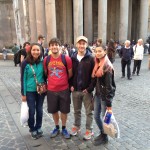Parkway students travel on educational trips to Europe

During spring break, several Parkway North students traveled along with teachers to Europe. Students traveling looked at art, architecture, and learned about a whole new culture.
“I really enjoyed seeing the history and culture come to life and being with the students as they saw it for the first time,” said Latin teacher Maura Tobin.
Two separate trips conducted through the tour company EF Tours traveled to Europe over spring break. One trip, headed by social studies teacher Will Vogt and English teacher Allison Cundiff was designed for students in AP European History and Masterpieces and focused on both Renaissance and Greco-Roman culture. The other trip, headed by Parkway West Latin teacher Tom Herpel, was designed for students in the Latin program and focused on understanding the ancient Roman culture. Nevertheless, the content included in both trips overlapped in several ways.
“We visited the Bay of Naples area for four days…then we went to Rome…and we spent four days there visiting sites there like the Colosseum,” said Tobin.
Both trips traveled to Rome and saw famous sites including the Colosseum, Pantheon, the Roman Forum, and Vatican City. The trip headed by Cundiff and Vogt also saw sites in Greece including the Parthenon whereas the trip headed by Herpel visited the Bay of Naples area and several nearby archeological sites such as Pompeii, Herculaneum, and the port city Ostia Antica.
“I wish we had more time [in Italy]; I left wishing we could visit more places,” said Tobin.
Both trips to Europe packed a large number of sites into a relatively small number of days. For example, the trip headed by Cundiff and Vogt was in Europe for eight days, two of which were occupied by travel. The trip headed by Herpel was ten days but two and a half days were spent traveling between sites. Despite this, both trips maximized the number of sites in the time offered.
“[The trip] gave me the impression that the Roman people had a very different mindset…and the large amount of art and architecture was the most striking,” said senior Kristen Von Till.
The main goal of both trips was to expose students to art and architecture that they had discussed but had not actually seen in real life. Overall, traveling to Europe was a learning experience where students got the chance to see first hand the works by ancient cultures.
By Gianna Sparks, Copy Editor
